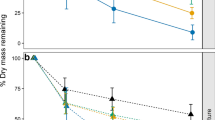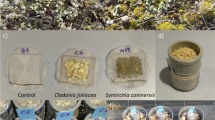Summary
Rates of disappearance of dead material of Polytrichum alpestre and Chorisodontium aciphyllum from a moss turf community and of Drepanocladus uncinatus, Calliergon sarmentosum and Cephaloziella varians from a moss carpet community, measured using litter bags over 2 years, were 1.5% year-1. Decomposition potential, estimated using loss in tensile strength of cotton strips inserted into the different bryophytes on the two sites, was also low. Ranking the five plant species in order of decomposition potential, from highest to lowest, gave D. uncinatus, C. aciphyllum, C. sarmentosum, P. alpestre and C. varians. The time taken for the tensile strength of the cotton strips at depths of 1–3 and 4–6 cm beneath the surface to decline by 50% varied from 1–2 years under the first two species to 3–4 years beneath the last two species. The main causes of these slow rates were low temperatures, short active season and low pH. Differences in decomposition between species, sites and with depth were related to temperature, nutrient status, water content and anaerobic conditions. Variation in anaerobic conditions beneath D. uncinatus, C. sarmentosum and C. varians in the moss carpet resulted in wide variation of decomposition rate beneath these species and with depth beneath C. varians. The peat in the moss turf was aerobic and experienced higher temperatures, but the average decomposition rate was no higher than in the moss carpet, because the peat was of a poorer quality and had a lower pH.
Similar content being viewed by others
References
Allen SE, Grimshaw HM, Parkinson JA, Quarmby C (1974) Chemical analysis of ecological materials. Blackwell, Oxford
Baker JH (1972) The rate of production and decomposition of Chorisodontium aciphyllum (Hook, fet Wils.) Broth. Br Antarct Surv Bull 27:123–129
Collins NJ (1975) Studies on the productivity of Antarctic bryophytes. PhD Thesis, University of Birmingham, Birmingham, UK
Collins NJ, Baker JH, Tilbrook PJ (1975) Signy Island, maritime Antarctic. In: Rosswall T, Heal OW (eds) Structure and function of tundra ecosystems. Ecol Bull, vol 20. Swedish Natural Research Council, Stockholm, pp 345–374
Coulson JC, Butterfield J (1978) An investigation of the biotic factors determining the rates of plant decomposition on blanket bog. J Ecol 66:631–650
Davis RC (1980) Peat respiration and decomposition in Antarctic terrestrial moss communities. Biol J Linn Soc 14:39–49
Davis RC (1981) Structure and function of two Antarctic terrestrial moss communities. Ecol Monogr 51:125–143
Fenton JHC (1978) The growth of Antarctic moss peat banks. PhD Thesis, University of London, London, UK
Fenton JHC (1980) The rate of peat accumulation in Antarctic moss banks. J Ecol 68:211–228
Heal OW, Howson G, French D, Jeffers JNR (1974) Decomposition of cotton strips in tundra. In: Holding AJ, Heal OW, MacLean SF, Flanagan PW (eds) Soil organisms and decomposition in tundra. Tundra Biome Steering Committee, Stockholm, pp 341–362
Heal OW, Latter PM, Howson G (1978) A study of the rates of decomposition of organic matter. In: Heal OW, Perkins DF (eds) Production ecology of British moors and montane grasslands. Ecological studies, vol 27. Springer, Berlin pp 135–159
Latter PM, Howson G (1977) The use of cotton strips to indicate cellulose decomposition in the field. Pedobiologia 17:145–155
Limbert DWS, Farman JC (1976) Anual summary tables of surface meteorological observations at British Antarctic Survey Stations. Br Antarct Surv Bull 44:27–29
Limbert DWS, Loan RSB (1976a) Climatological summary for 1971. Br Antarct Surv Bull 44:31–37
Limbert DWS, Loan RSB (1976b) Climatological summary for 1972. Br Antarct Surv Bull 44:39–45
Limbert DWS (1977) Climatological summary for 1974. Br Antarct Surv Bull 45:139–145
Limbert DWS (1979) Climatological summary for 1975. Br Antarct Surv Bull 47:129–135
Longton RE (1972) Growth and reproduction in northern and southern hemisphere populations of the peat-forming moss Polytrichum alpestre with reference to the estimation of productivity. Proc 4th Int Peat Congr I, International Peat Society, Helsinki, pp 259–275
Phillipson J (1964) A miniature bomb calorimeter for small biological samples. Oikos 15:130–139
Swift MJ, Heal OW, Anderson JM (1979) Decomposition in terrestrial ecosysems. Blackwell, Oxford
Tilbrook PJ (1973) The Signy Island terrestrial reference sites. 1. An introduction. Br Antarct Surv Bull 33/34:65–76
Walton DWH, Allsopp D (1977) A new test cloth for soil burial trials and other studies on cellulose cecomposition. Int Biodeterior Bull 13:112–115
Woods PV, Raison RJ (1982) An appraisal of techniques for the study of litter decomposition in eucalypt forests. Aust J Ecol 7:215–225
Wynn-Williams DD (1980) Seasonal fluctuations in microbial activity in Antarctic moss peat. Biol J Linn Soc 14:11–28
Wynn-Williams DD (1984) Comparative microbiology of moss-peat decomposition on the Scotia Arc and Antarctic Peninsula. In: Siegfried WR, Condy PR, Laws RM (eds) Antarctic nutrient cycles and food webs. Springer, Berlin, pp 204–210
Wynn-Williams DD (1985a) The Signy Island terrestrial reference sites. 16. Peat O2-uptake in a moss turf relative to edaphic and microbial factors. Br Antarct Surv Bull 68:47–59
Wynn-Williams DD (1985b) The Signy Island terrestrial reference sites. 17. Peat O2-uptake in a moss carpet relative to edaphic and microbial factors. Br Antarct Surv Bull 68:61–69
Author information
Authors and Affiliations
Rights and permissions
About this article
Cite this article
Davis, R.C. Environmental factors influencing decomposition rates in two Antarctic moss communities. Polar Biol 5, 95–103 (1986). https://doi.org/10.1007/BF00443381
Received:
Accepted:
Issue Date:
DOI: https://doi.org/10.1007/BF00443381




